|
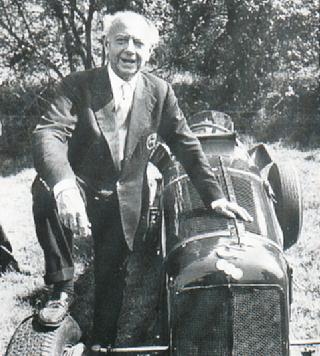
|
Thomas
Raymond
Mays
CBE
(1899-1980) |
The pioneer of British motor racing, Thomas Raymond Mays,
always known as Raymond, brought prestige to Bourne and took this country to the forefront of international competition on the track.
He was the son of a local businessman and motoring enthusiast, Thomas William Mays, a wool merchant and fertiliser manufacturer, whose interest was in hill climbs and speed events. The family residence was an imposing Regency house in Eastgate and a plaque on the front wall reminds us that he was born here on 1st August 1899 and that this was his lifetime home. Twenty years later he owned his first car, a speed model Hillman which was traded in for a Bugatti Brescia called Cordon Rouge, after the famous brand of champagne, and a second Bugatti followed, this time called Cordon Bleu, after the brandy.
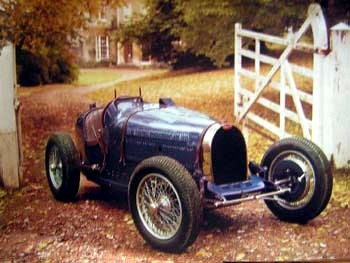
The two Bugattis proved quite formidable during the 1924 racing season, sweeping the board in the big hill climb events and creating new records.
The beginning of Raymond's career as a motor manufacturer
had begun quietly, almost secretly, at his home in Bourne and few people knew
about the venture until it was revealed by the Stamford Mercury during 1934,
the year English Racing Automobiles, or ERA as it was known, was formed
using workshops built on the orchard adjoining Eastgate House. Their
exclusive reports are reproduced below.
|
Friday 25th May 1934
SUPER- CARS BUILT IN
BOURNE
THREE RACERS UNDER CONSTRUCTION
RAYMOND MAYS' VENTURE
CONTINENTAL "ACES" CHALLENGED
RAYMOND
MAYS, the famous Bourne racing motorist, is hard at work preparing
a surprise for the crack drivers of the Continent, who in recent
years have wrested from Britain several important motor-racing
records.
Assisted by a small following of skilled mechanics, he is building
in the heart of Bourne three super-racing cars with which he hopes
to carry off for Britain some very important races at the expense
of foreign drivers.
Few people in Bourne are aware of the fact that under their noses,
as it were, there are being born three racing cars which may well
make history when they appear on the track. Although there is no
actual secrecy about this very important work, it has not been
broadcast to anybody and everybody, and consequently many
residents of the town in which the work is being carried out have
no inkling as to what is going on.
In the grounds of Eastgate House, where Mr Mays lives, there has
grown up in the past few months a two-story workshop-garage of
asbestos, in which the three new cars - ERA's - are being
assembled. The site of the workshop was formerly an orchard, and
the building is so situated that unless one were on the lookout
for it, one would pass by without having any idea of its presence.
It stands well back from the road and is well surrounded by
buildings and high walls.
COMPANY FORMED
ERA,
the style of the cars, hides the identity of a company of English
Racing Automobiles Ltd, which is financing the venture. The prime
movers in the concern are Mr Raymond Mays and Mr Humphrey Cook,
the veteran racing motorist.
A director of the company is Mr Peter Berthon, a clever young car
designer whose brain is behind the construction of the car. It is
expected that they will be capable of a speed of nearly 150 miles
an hour.
The engineer-designer of Blue Bird, the car in which Sir Malcolm
Campbell set up the world's motor speed record, Mr Reid Railton,
also assists in the work. Mr Berthon has been responsible for the
design of the engines, and Mr Railton has produced the chassis.
Work has gone on day and night for some months in the workshop,
which is packed with up-to-date machinery such as is not to be
found anywhere else in the country.
A whole week was spent by a mechanic on the machining and
polishing of the cylinder head of one of the engines in an effort
to make the work absolutely dead accurate.
At the moment three engines of 9,12 and 16 horse power
respectively, are under construction.
Brooklands will be the scene of the first tests of the cars when
they are completed, after which they will participate in the
Mannin Reg and Mannin Boar races in the Isle of Man, two of the
most important motor-racing events which attract British drivers.
Friday
7th September 1934
140
MPH IN 38 SECS! MR
RAYMOND MAYS' TRACK SUCCESS BOURNE
CARS' TRIUMPH Further
successes for the new ERA (English Racing Automobile) cars, which
were recently built in secret at Bourne under the direction of Mr
Raymond Mays and Mr Humphrey Cook, two famous figures in the motor
racing world, were gained last week when two ERA's appeared on the
Brooklands track. When
the first car - with a 1500 cc engine - was built, it met with
little success and much hard luck at its initial appearance on the
track. Little daunted by this early set back, a second car with an
engine of 1100 cc cylinder capacity was constructed and on August
Bank Holiday, both cars broke class records. Last
week, the terrific acceleration of the cars was demonstrated on
the Brooklands track when several successes by both Mr Mays and Mr
Cook were obtained. In
the larger capacity car, Mr Mays put up the record for the
standing start kilometre (Class F) to 85.35 miles an hour from
83.09. The amazing acceleration of the car was demonstrated in the
standing start mile when an average speed of 96.03 mile an hour
was reached against the previous best of 92.33. As an illustration
of the car's amazing pick-up, Mr Mays was travelling at just under
140 miles an hour at the end of the mile, this speed being
attained in less than two-thirds of a minute! The
second ERA, driven by Mr Humphrey Cook, was just as successful. In
the standing kilometre (Class G), Mr Cook reached an average speed
of 79.75 miles an hour, against the old figure of 78.33 and over
the standing start mile, he averaged 88.91, this increasing the
old record by 5.71 miles an hour. |
Motor racing was halted during the Second World War from 1939 to 1945 but by then Mays was pondering on the possibility of an all-British racing car to break the foreign domination of Grand Prix motor racing and so British Racing Motors, or BRM as it came to be known, was formed and financial backing came from leading companies in the field, particularly Rubery Owen and Company
Limited and Joseph Lucas Ltd. The first BRM was unveiled and demonstrated to the motoring world at Folkingham airfield on 15th December 1949 when the car was hailed as a world beater, although success was slow in coming. More tuned-up production cars followed and in 1960, new workshops for the development of the BRM were built on
the site of the old gasworks in Spalding Road.
There were many failures and some successes. New engines and cars were
designed and in 1962, the BRM
became the first all-British car to win the world championship and the
company's Number One driver Graham Hill, father of the present day Damon,
became world champion at the same time. This accolade from world motor
racing was marked by a civic reception at the Corn Exchange in March 1963 organised by the old Bourne Urban
District Council when Hill was presented with a silver
salver for his achievement. Mays himself was to be honoured in 1978 with a
CBE for his services to motor racing.
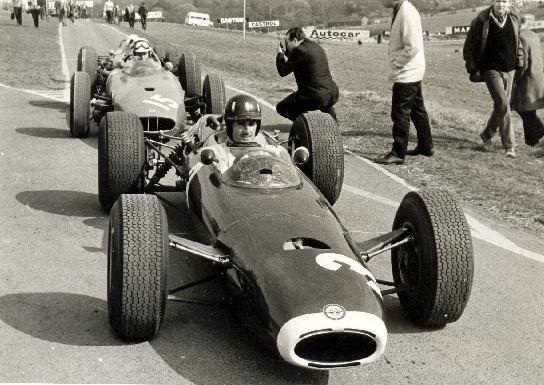 |
|
Graham Hill at the wheel of the championship BRM in 1965.
|
By 1965, BRM had 100 employees in Bourne and this was another victorious year when BRM cars gained either a first or second prize in every Grand Prix race that was held. But after that, their cars had mixed fortunes until the Mexican driver Pedro Rodriguez scored a comeback victory in the 1970 Belgium Grand Prix at Spa. There were further successes but advancement was dogged by mechanical failures and soon after Mays died in 1980, Rubery Owen decided to sell the BRM collection of racing cars and the sale created international interest when it took place during the Motor Show at Earl's Court, London, in October 1981.The BRM
site in Spalding Road was sold for commercial development to Delaine Buses
and the workshops are now used as an auction salesroom.
|
A portrait in oils of Raymond Mays hangs in the Red Hall at Bourne. It was painted in 1950 by Sofy Asscher and bears a plaque with the inscription:
"Presented to Raymond Mays by personal friends after 30 years of motor racing".
The painting was bequeathed to the town by the sitter who asked that it be hung in the Red Hall after his death. His
CBE was offered for sale after his death when, in March 1994, it fetched just under £400 at Sotheby’s auction rooms in London. |
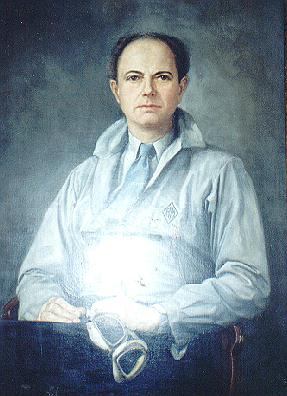
|
Graham Hill was killed when the plane he was piloting crashed near London in 1975 but his name lives on in Bourne in Graham Hill Way, a small industrial estate off Cherryholt Road, where motor racing is alive and well. Pilbeam Racing Designs, which grew from the staff leaving BRM when it closed, is well established there in a £300,000 factory opened in 1997 by Graham's widow Bette.
Motor racing has been much maligned in recent times because the engines on four wheels that now speed around the track bear little resemblance to the motor cars of past times. There is also much criticism of its dependence on tobacco advertising and of sponsorship by petrol, tyre and battery companies. Raymond Mays and his cars were from a different age but it was his enthusiasm and expertise that gave the sport a new impetus in the years following the Second World War.
Raymond Mays however, died on 6th January 1980 with debts of £150,000, his
house heavily mortgaged and most of the valuable contents already sold.
These included a series of original water colour paintings by the motoring
artist Gordon Crosby, showing Raymond Mays in action on the track, that
had been bought by a Swiss count with the proviso that they would stay on
the walls of Eastgate House until Raymond's death and when this eventually
occurred in 1980, they were collected by the owner and shipped to his home
in Switzerland. The house itself and what was left of the family estate
were eventually sold and the money raised went to help pay his debts.
All of Raymond's cars were sold at
Christie's auction house in London after his death and in his will he left
over 120 of his prize silver cups and trophies to various friends. The
number would have been higher but his mother had already given away many
as wedding presents.
The funeral was held at the Abbey
Church in Bourne which was filled with mourners from the town and the
world of motor racing, followed by private cremation at Grantham.
There was also a small gathering for tea afterwards at the Angel Hotel
when tributes were paid by his motor racing friends and he was also
honoured with a national memorial service at St Paul's Church,
Knightsbridge, London, on 22nd January.
During the service at the Abbey Church,
a fulsome tribute was paid by his old friend, the Rt Rev Kenneth
Riches, a former Bishop of Lincoln, who spoke of the two Raymond Mays.
He said:
There was the young racing star of the
twenties and thirties, the matinee idol who fifty years ago thrilled
multitudes in many different countries, and there was the careful
perfectionist whose immense respect for detail meant nothing short of
the best would ever do for him. Thanks to his lively inventiveness of
mind, the genius with which he pursued it, and his courage and daring,
he became one of the greatest, if not the greatest, racing motor
drivers of his generation.
|
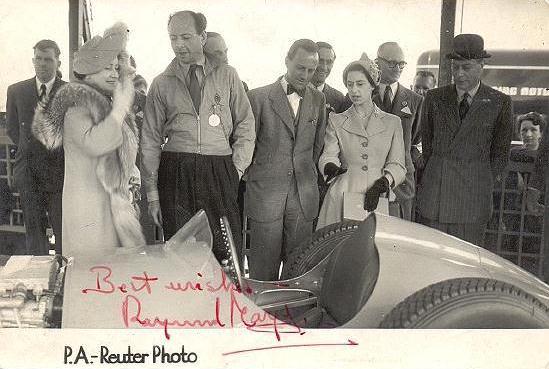 |
|
One of the proudest moments in Raymond
Mays' life was his meeting with Queen Elizabeth and Princess
Margaret at the Silverstone circuit on 13th May 1950
when he
showed them the BRM. He treasured copies of this photograph
and
autographed many which he handed out to friends and
admirers. |
There are many of the older generation in the town who have little regard for Raymond Mays because they blame his playboy lifestyle and his obsession with motor racing as the reason for the collapse of the Mays company that had provided secure employment for so many for more than 100 years. His efforts to keep the BRM project going was a succession of financial deals with London bankers that eventually dissipated the business empire founded by Raymond's great-grandfather William Mays and expanded by his son and grandson, and the fortune they had accrued.
Raymond was a celebrity, having developed a car that put Britain firmly on the international motor racing circuit but whether the price he paid was worth it is a matter of conjecture. There was not even enough money in his estate to pay for a memorial headstone in the town cemetery where his ancestors are buried. He was cremated after his death and his ashes were not preserved.
The Raymond Mays Room at the Heritage Centre in Baldock’s Mill in Bourne
contains a wealth of memorabilia about the motor racing pioneer such as
his goggles, some of his trophies, documents and photographs. The
exhibition also remembers all of those who were involved with Raymond Mays
in the production of those racing cars that brought prestige to Britain
and international motor sport. This is a particularly noteworthy
enterprise because it has been financed and executed entirely by
volunteers anxious to preserve the name of someone who brought fame to our
town. Its main funding comes from the publication of an illustrated
booklet Raymond Mays of Bourne produced in 1994 by Dr. Michael McGregor, a
retired local general practitioner, and comprises almost 200 early
photographs from Raymond Mays’ career which were found in a trunk in the
attic of his home after he died.
|
REMEMBERING
RAYM0ND
In the summer of 2002, a road on
the new Elsea Park residential development to the south of the
town was
named Raymond Mays Way in his honour and a memorial to both
him and the town's motor racing connections was erected
alongside the Bourne Eau in South Street in 2003 |
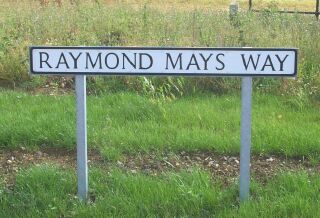 |
|
FROM THE ARCHIVES |
|
AN EARLY MISHAP ON THE ROAD
Raymond's first experience of a car crash was when he was only ten years old. He was a frequent passenger whenever his father, Thomas Mays, went out driving and while motoring home on the evening of Friday 20th August 1909, his vehicle hit a bullock on to the main road near Rippingale.
Raymond was thrown from the car by the impact and was badly shaken but not seriously hurt.
His father said afterwards that the animal had strayed from a field on to the roadside verge where it had been attracted by the headlights and dashed in front of them. He had not seen it until the impact which badly damaged the front of the car but not sufficiently to prevent them from completing their journey although the bullock was killed. |
|
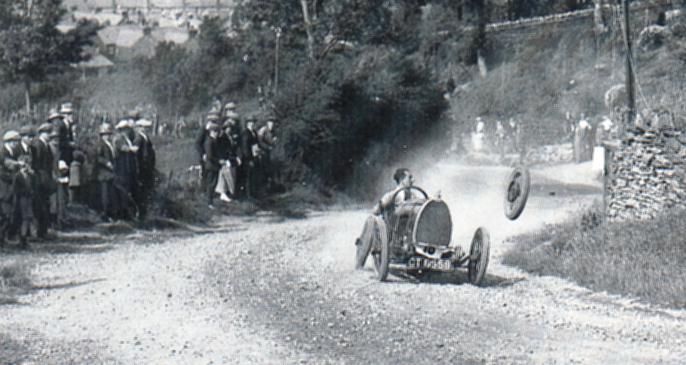
THE DAREDEVIL
HIMSELF
Tales abound of the way in which
Raymond Mays lived his life, always to the full and without a care for tomorrow. He had little regard for money and even for his own health because he was still smoking furiously at the age of 68. During the years before the Second World War when his name had become synonymous with speed, daring, skill and record breaking, one journalist remarked: "He would either break the record or break his neck. The unnerving thing was that he knew it." Mays was a great admirer of the Bugatti and he was driving such a car in the Caerphilly mountain hill climb near Cardiff in August 1924 when the nearside rear axle broke and the wheel came off, overtaking him at some speed. A photographer was on hand to catch the moment and his dramatic picture is reproduced above. Miraculously, Mays lived to be 80.
Raymond Mays
also had a narrow escape from tragedy while competing in Yorkshire during the late summer of 1924. The
Stamford Mercury reported his exploits on Friday 3rd October as follows:
BEAT DEATH BY A SHORT HEAD
HAIR-RAISING ADVENTURE ON RACING TRACK
LOCAL MOTORIST'S THRILLING EXPERIENCE
At the Bradford and Huddersfield Automobile Club's annual hill climb at Holme Moss, near Holmfirth, on Saturday, the times put up were very fast,
Mr Raymond Mays, in a Vauxhall, lowering the record for the hill, which is a mile and a quarter long, by fully six seconds. The existing record was 1 minute 21 seconds made by Malcolm Campbell two years ago.
The crowd collected at the hairpin bend to watch the cornering missed the
real thrill of the afternoon, which was given at the summit by Mr Raymond Mays in a startling experience which can scarcely have happened before to a competitor in a hill climb. Mr Mays, driving a Bugatti in the first amateur event, had climbed the hill in the very
fast time - which he twice beat later in the Vauxhall - of 1 minute 17-1.5 seconds, and had crossed the line at eighty miles an hour when his accelerator pedal jammed at full throttle. At the same moment, the clutch pedal broke and when he tried to switch off the engine he found
the switch ineffective, an extraordinary series of coincident mishaps.
Unable as he was to reduce his speed, the position of Mr Mays was one of
great peril. The road narrows at the top, with a twist in it. On the one side
the hill slopes up from this road rather sharp, on the other there is a steep drop into a deep ravine. With a flash of inspiration. Mr Mays, to avoid the crowd at the, top, charged up the hill, glided along it for a short distance with the car at a perilous angle, then bounded on to the road again, the car taking a leap of fully twenty yards in the air. It then shot across the road and travelled for a short distance with the near side wheels bare inches from the edge of the ravine. By a tremendous effort, steering meanwhile with one hand only, the driver managed to force the gear lever into neutral without the aid of the clutch, and finally brought the car to a standstill, stopping the roaring engine by turning off the petrol tap. He then fell out of the car from sheer nervous exhaustion.
It was in a subsequent event that he broke the record for the hill. Even then his luck was none too great, for
in the Vauxhall he had a puncture halfway up the hill, and a slight fire, which was quickly extinguished. He gave a really great exhibition of skilful driving.
The events won by Mr Mays included that for cars of 2501cc and over (Vauxhall 2966 cc), 1 minute 15-3.5 seconds; and that for cars of any cc, fastest time only (Vauxhall 2996 cc), 1 minute 15 seconds. He also won third prize in the event for cars up to and not exceeding 1550 cc.
BRUSHES
WITH THE LAW Raymond
Mays also regarded the laws relating to motoring rather lightly and
was summonsed on at least two occasions. In October 1959, he
was fined £10 for speeding at Preston in Lancashire but there
was a far more serious charge almost 40 years before when he appeared
before magistrates at Peterborough on Wednesday 10th October
1923 accused of dangerous
driving. He was represented by local solicitor Mr Arthur
Mellows and pleaded not guilty but the evidence offered in his
defence may appear to be rather light-hearted. Police told the
court that Mays had been seen driving his car near St Paul's
Church [in Lincoln Road] where there were crossroads "at
a speed of fully 30 miles an hour". Mr Mellows, in
his defence, reminded the magistrates that Mays was a
well-known racing motorist and had passed many stringent
driving tests and was not in the habit of using the main roads
for racing. During the past eight years, he had driven about
20,000 miles and had not scratched a mudguard or knocked
anyone down. No complaints had been made against him.
"His car", said Mr Mellows, "is so built that
it looks to be travelling faster than it really is." He
was found guilty and fined £3 (£110 in today's money) and
ordered to pay costs. |
|

|
Cigarette card issued by W A & A C
Churchman, Ipswich, Suffolk, in 1939, and distributed in their
packets of cigarettes during the hey-day of
cigarette card collecting. This card is from a set of 50 cards
from a series entitled Kings of Speed and shows Raymond Mays,
described as "a brilliant amateur driver" who broke the Shelsley Hill climb record. Cigarette cards are highly prized
today and this copy is likely to fetch £5-£10 although the
complete set would run well into three figures. |
|
EXPENSIVE FAILURE
One of the less well known of Raymond's activities was a
short-lived venture in the production car market in the 1930s. He based the car that was to bear his name on the recently introduced Standard V8 engine and gearbox unit. The 20 h p car had four forward gears and could accelerate from start to 60 m p h in 18 seconds and had an overall speed of over 90 m ph which was considered average for
similar cars of the period.
The cars arrived from the Standard works in Coventry partially built and were finished at the workshops in Bourne. The chassis price was £375 with two body styles, a sports four-seater or a very attractive drop-head coupe with a distinctive and very stylish grille, both
costing £495 each. A sedan was also available and specialist coachwork was
provided to order. The prototype performed creditably at the R A C Rally in 1939 and all was set for production to get underway in the autumn of that year but the war intervened and only five were ever made.
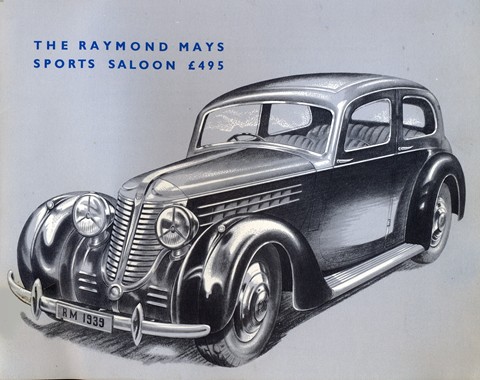
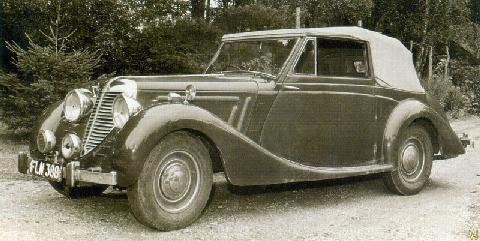 |
Raymond Mays -
man about town The theatre Desert
Island Discs
A cartoon
by Sallon A cartoon
by Giles
Raymond Mays - a
pictorial scrapbook BRM
historic recording - 1955
Building the new BRM
workshops The Bourne motor
racing memorial
Why Bourne should
remember Raymond Mays
Early days on
the road
Car v plane Racing trials on
fen roads
An incident in
Germany Raymond Mays
meets Malcolm Campbell
Personnel who
worked for BRM
Alec Stokes Tony Rudd
The BRM civic
reception Sale of the ERA
prototype in 2008
See also
Prince Bira Trissie
Carlton Richard Salmon
* Sales of the booklet Raymond Mays of Bourne have already raised
more than £10,000 for the Heritage Centre and memorial room and copies are still
available at weekends from Baldock’s Mill, price £6, and from Walkers Books at 19 North Street, Bourne, Lincs. PE10 9AE, United Kingdom.

Go to:
Main Index
|









